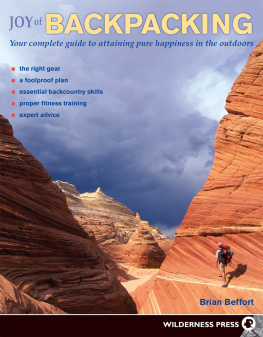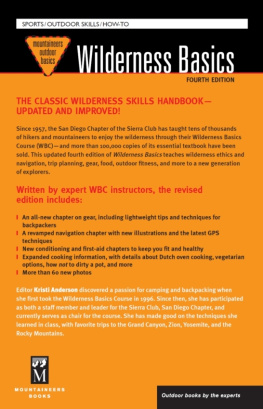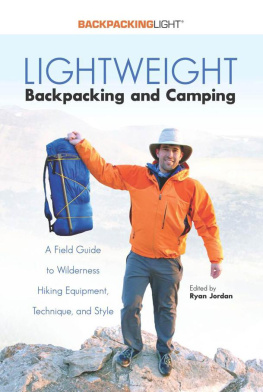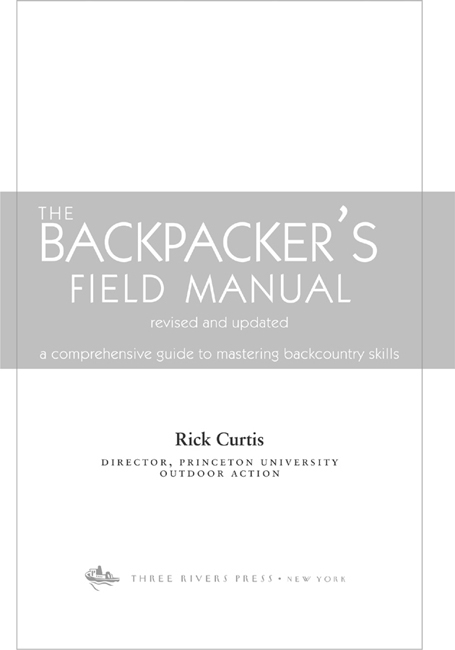The publisher gratefully acknowledges permission to reprint excerpts from Mountain Safety, Research Inc.s instructions for the Whisperlite stove and for artwork illustrating the Whisperlite stove; Arcteryx for providing a backpack for the cover art; the Leave No Trace Center for Outdoor Ethics for permission to use the Leave No Trace logo; MapTech, Inc. for U.S.G.S. quadrangle maps generated from MapTech Terrain Navigator Pro; Sierra Club Books for excerpts from Weathering the Wilderness, by William E. Reifsnyder; artwork showing the SAM splint from the Seaburg Company; the MapTools UTM grid artwork from John Carnes at MapTools.com; The Physician and Sports Medicine Journal for excerpts from the article Self-reduction of Anterior Shoulder Dislocation by Dr. Elizabeth Joy (November 2000); Prentice Hall for an illustration of the Situational Leadership Model from Management of Organizational Behavior by Paul Hersey, Kenneth Blanchard, and Dewey Johnson.
Copyright 1998, 2005 by Rick Curtis and Princeton University
Illustrations copyright 1998, 2005 by Ron Hildebrand and Rick Curtis
All rights reserved.
Published in the United States by Three Rivers Press, an imprint of the Crown Publishing Group, a division of Random House, Inc., New York.
www.crownpublishing.com
THREE RIVERS PRESS and the Tugboat design are registered trademarks of Random House, Inc.
Originally published in different form by Three Rivers Press, an imprint of the Crown Publishing Group, a division of Random House, Inc., New York, in 1998.
Library of Congress Cataloging-in-Publication Data
Curtis, Rick.
The backpackers field manual : a comprehensive guide to mastering backcountry skills / Rick Curtis.Rev. and updated.
Includes bibliographical references and index.
1. BackpackingHandbooks, manuals, etc. 2. CampingHandbooks, manuals, etc. 3. Low-impact campingHandbooks, manuals, etc. I. Title.
GV199.6.C87 2005
796.51dc22 2004023668
eISBN: 978-0-307-95629-3
v3.1
ACKNOWLEDGMENTS
I want to thank the many close friends with whom I have traveled the trails, peaks, and rivers over the years: Liz Cutler and Tom Kreutz; John Gager; Ed Seliga; Philo Elmer; all the other folks and places who have enriched my outdoor experiences; and especially my mom, Ann Curtis, for all her love and encouragement throughout my career in outdoor education.
In writing this second edition Ive relied on my own thirty years of experience in the outdoors as well as seeking out some of the best experts in different fields to bring you the most complete information possible (and still fit within my publishers page limits). One thing Ive learned over the years is to recognize what I know and what I dont know; a lot of people have been essential at helping fill in my knowledge gaps. For all their help and guidance with the first edition I want to thank Tod Schimelpfenig at the National Outdoor Leadership School for his review of ; Professor Stephen Herrero of the University of Calgary for his review of the information on bears and bear attacks; Dr. Martin Uman, John Gookin, and Richard Kithil for helping me to understand the physics of lightning; my friend Brent Bell, director of Harvard Universitys Freshmen Outdoor Program for information about dealing with diabetes on the trail; Dr. Robert Brownie Schoene, former President of the Wilderness Medical Society, for his help on altitude illnesses; and my good friend Bill Tigerpaw Plonk, who gave me firsthand information about ultralight hiking after his successful 2002 ultralight through-hike of the Appalachian Trail.
Finally, I want to thank all of the Princeton University students who have been leaders in the Outdoor Action Program since 1973 and have helped to develop and implement our principles of outdoor education. These wonderful people have volunteered their time to teach others the joy of being in the wilderness. To all of you, especially to the many Leader Trainers who I have spent so much wonderful time with, thank you so much. You all have made me so proud of what you have accomplished at Princeton with your peers, and how you have taken your leadership skills out into the world to make a difference. Over the years more than 13,000 Princeton students have participated in the program, and Outdoor Action has become one of the leading college outdoor programs in the country. Outdoor programs from across the country and around the world look to Outdoor Action for help in developing their programs and training leaders. Through our educational efforts on campus, this book, and our Web publishing at www.princeton.edu/~oa, www.outdoored.com, www.outdoorsafety.org, and www.backpackersfieldmanual.com, we hope that you will have a productive and safe learning experience wherever you go.
CONTENTS
INTRODUCTION
Back in 1996, when I was writing the first edition of The Backpackers Field Manual, the World Wide Web was still in its infancy. Since then the Internet has revolutionized the way we search for information and interact with one another. Backpacking and outdoor sports are no exception to this, from finding hiking trails to searching for gear reviews. Backpacking and outdoor recreation, like everything else, have become information-driven. Your knowledge base is a key part of maximizing your enjoyment, your safety, and your stewardship of the natural world.
Since the first edition, backpacking itself has changed. Advances in gear design now mean that a seven-day trip no longer means a seventy-pound pack. Weve expanded our comfort range in all sorts of seasons and learned how to hike thousands of miles with less than twenty pounds of gear in our packs. We can use GPS receivers to pinpoint our exact location and tell us how to hike to our next campsite. At the same time, backpackers face new challenges today. The growth of outdoor recreational sports has put millions of more people on the land. Leave No Trace practices and wilderness conservation have become increasingly important to safeguard the wild lands we all love. Weve also seen new hazards emerge like West Nile Virus and Crypotosporidium.
With all our advances in technology, there still exists a set of core skills that people need to travel in the outdoors. We seem to forget that the earliest backpackers, in the United States and Canada, from native peoples to backcountry explorers like Lewis and Clark, didnt have Gore-Tex, polypropylene ultralight tents, and a gas stove. They survived the harshest conditions with wool, leather, canvas, and yes, even cotton, through their deep knowledge of how to take care of their own needs in the outdoors.
With all these changes it was time to write a new edition of The Backpackers Field Manual. Ive used the first edition as our main textbook for teaching new outdoor leaders at Princeton University. Other schools and outdoor programs across the country use it as a textbook for backpacking and outdoor recreation courses and as a staff field manual. The first version of this book was a twenty-page manual written for our trip leader back in 1985. The manual continued to grow each year until 1996, when I began working with Random House to produce a book-length version. This new edition brings the book up to date with changes in backpacking and expands the book to cover more aspects of outdoor leadership and education. Its a great book for beginners who need comprehensive instruction for planning and running their own outdoor trips. For experienced hikers its a solid reference manual and refresher for your next trip. There are lots of good backpacking books out there, and I reference a lot of them in the Bibliography. Unlike any other book on the market,







